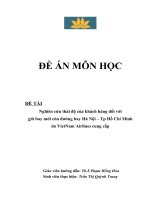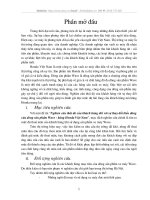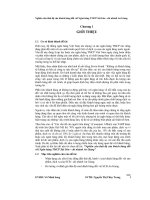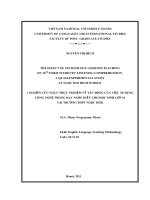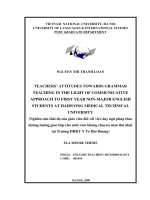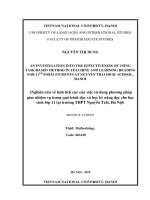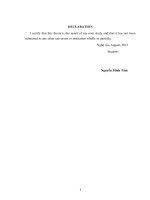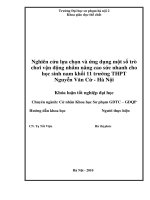Nghiên cứu thái độ của giáo viên đối với việc dạy từ vựng theo đường hướng giao tiếp cho học sinh lớp 10 tại trường THPT Nguyễn Văn Cừ
Bạn đang xem bản rút gọn của tài liệu. Xem và tải ngay bản đầy đủ của tài liệu tại đây (598.46 KB, 44 trang )
VIETNAM NATIONAL UNIVERSITY, HANOI
UNIVERSITY OF LANGUAGES & INTERNATIONAL STUDIES
POST GRADUATE DEPARTMENT
NGUYễN THị THANH HằNG
TEACHERS ATTITUDES TOWARDS APPLYING CLT IN
TEACHING VOCABULARY FOR GRADE-10 STUDENTS
AT NGUYEN VAN CU HIGH SCHOOL
( Nghiên cứu thái độ của giáo viên đối với việc dạy từ vựng theo đ-ờng h-ớng giao
tiếp cho học sinh lớp 10 tại Tr-ờng THPT Nguyễn Văn Cừ)
M.A MINOR THESIS
FIELD: ENGLISH TEACHING METHODOLOGY
CODE:
SUPERVISOR: Dr. Đỗ TUấN MINH
HANOI, 2010
TABLE OF CONTENTS
Declaration
Acknowledgement
Abstract
Table of contents
Abbreviation
List of tables
PART A: INTRODUCTION Pages
1. Rationale 1
2. Aims of the study 1
3. Significance of the study 2
4. Scope of the study 2
5. Research questions 2
6. Methods of the study 2
7. Design of the study 2
PART B: DEVELOPMENT
CHAPTER 1: LITERATURE REVIEW 4
1.1. Vocabulary and its status in language teaching and learning 4
1.1.1. Definition of vocabulary 4
1.1.2. The status of vocabulary in language teaching and learning 4
1.2. An overview on language teaching methods in teaching vocabulary 4
1.2.1. The Grammar- Translation Method 5
1.2.2. The Direct Method 5
1.2.3. The Audio-lingual Method 5
1.3. CLT on teaching vocabulary 5
1.3.1. Definition of CLT 5
1.3.2. Characteristics of vocabulary communicative activities 6
1.3.3. Vocabulary teaching techniques in combination with communicative activities 6
1.4. Factors affecting teachers’ attitudes 8
1.4.1. Definitions of teachers’ attitudes 8
1.4.2. Factors affecting teachers’ attitudes 8
1.5. Summary 10
CHAPTER 2: THE INVESTIGATION 11
2.1. Current situation of the teaching and learning of English at Nguyen Van Cu High
School
2.1.1. School factors 11
2.1.2. Teachers’ factors 11
2.1.3. Learners’ factors 12
2.1.4. The teaching materials 12
2.2. Methodology 13
2.2.1. Subjects of the study 13
2.2.2. Data collection instrument 13
2.2.3. Data analysis and result 15
2.2.3.1. Results and discussions from the questionnaires 15
2.2.3.2. Results and discussions from the observation 26
2.2.3.3. Results and discussion from the interviews 28
CHAPTER 3: FINDING AND SOME POSSIBLE SOLUTIONS 29
3.1. Finding 29
3.1.1. Teachers’ attitudes towards applying CLT in teaching vocabulary for grade-10
students at NVCHS 29
3.1.2. The reason causing teachers’ attitudes in teaching vocabulary communicatively and
their own solutions 29
3.2. Suggestions 30
3.2.1. Suggestions for overcoming the problems in teaching vocabulary communicatively
3.2.1.1. Training and retraining teachers in CLT 30
3.2.1.2. Redefining students’ role and teacher’s role 31
3.2.1.3. Changing students’ attitudes towards learning English 31
3.2.1.4. Improving students’ motivation in learning vocabulary 31
3.2.2. Suggestions on vocabulary learning communicative activities for grade-10 students
at NVCHS 33
PART C: CONCLUSION AND SUGGESTIONS FOR FURTHER STUDY 38
1. Conclusion 38
2. Limitations of the study 39
3. Suggestions for further study 40
REFERENCES
APPENDIXES
1
PART A: INTRODUCTION
1. Rationale
Vocabulary is an essential element of language. Whether in speaking or writing, learners
need vocabulary to communicate and understand others. Unlike native speakers, second
language learners are unable to absorb new vocabulary from a natural, English-speaking
environment. They acquire language mostly by learning at school. However, in Vietnam
for most of teachers, the most common way to communicate meaning of words is by
translating through wordlist and many learners use rote strategies as their major way of
vocabulary learning.
Together with innovation in English teaching and learning methods everywhere in
Vietnam, the new series of English textbook for grade 10 was introduced nationwide in
academic year 2006-2007. The new textbooks are designed to apply the communicative
approach with learner-centered learning. This has leaded teachers and learners to face
some difficulties in English teaching and learning especially in teaching and learning
vocabulary. The reason is that it is the first time for them to adapt the new method of
teaching and learning instead of the old one, the grammar translation approach, which has
existed in our education for along time. As a teacher of English at Nguyen Van Cu High
School ( NVCHS), I found that thanks to the movement of Communicative Language
Teaching (CLT) many language teachers are now aware of the need to take vocabulary
seriously, but their students are unable to use English effectively. There maybe problems in
their students’ ways of using vocabulary, but problems in teaching vocabulary are
undeniable. In order to better vocabulary teaching and learning, I have conducted a
research to find out teachers’ attitudes towards applying CLT in teaching vocabulary for
grade 10, pointing out the main problems in teaching vocabulary communicatively, then
offering some solutions to these problems.
2. Aims of the study
The aims of the study as follows:
- To give brief overview about the role of vocabulary, its relevance in teaching and
learning methodology, and factors affecting teachers’ attitudes.
- To find out teachers’ attitudes towards applying CLT in teaching vocabulary for grade-10
students at NVCHS, and the reasons causing their attitudes.
2
- To make some suggestions on overcoming the teachers’ problems in the application of
CLT in teaching vocabulary.
3. Significance of the study
This study plays an important role in improving vocabulary teaching methods to grade-10
students at NVCHS. Its implicated suggestions will make the application of CLT at my
school successful and effective.
4. Scope of the study
As it has been stated above, the study aims to investigate the teachers’ attitudes towards
vocabulary teaching through communicative approach for grade-10 students. Then, based
on the teachers’ reasons leading different attitudes, some feasible solutions will be
introduced.
5. Research questions
To achieve the aims of the study, the following research questions were proposed:
1. In what ways do teachers at Nguyen Van Cu High School teach vocabulary to students?
2. Are teachers aware of the need to teach vocabulary communicatively?
3. What have teachers done to teach vocabulary communicatively?
4. What should teachers do to teach vocabulary communicatively?
6. Methods of the study
The research is done by both quantitative and qualitative methods; it is carried out on the
basic of situation analysis, material collection, survey questionnaires, class observations
and follow-up interviews.
In the first place, for the theoretical basis, a lot of reference material on vocabulary, its
relevance in teaching and learning methodology, and factors affecting teachers’ attitudes
have been gathered, analyzed and synthesized thoroughly. Secondly, situation analysis has
a look at the background to the study including the description of the current context at
Nguyen Van Cu High School.
Eventually, for the practical basis, questionnaires, classroom observation, follow-up
interviews were carried out with the teachers to gather the most reliable data for analysis to
find answer to the research questions mentioned above.
7. Design of the study
This thesis consists of three parts:
3
Part A is the introduction, which present the rationale, aims, significance, scope, research
questions methods and design of the study
Part B consist of three chapters
Chapter1 deals with a literature review. It starts with vocabulary and its status in language
teaching and learning, then an overview on language teaching methods in teaching
vocabulary. The next is about CLT on teaching vocabulary which includes the definition of
CLT, characteristics of vocabulary communicative activities, vocabulary teaching
techniques in combination with communicative activities. The final is some factors
affecting teachers’ attitudes.
Chapter2 presents the survey. First, there is a description about the present situation of
English teaching and learning at NVCHS. Second, the methodology is performed in the
study. It provides participants, instruments and data analysis.
Chapter 3 presents the findings and suggestions. Firstly, the findings of the study are
analyzed and discussed. Secondly, some suggestions for overcoming the problems in
teaching vocabulary communicatively for 10-grade students at NVCHS are proposed.
Some communicative activities for a vocabulary lesson are also recommended.
Part C is about the conclusion, and suggestions for a further study.
References and Appendixes come in the end of the study.
4
PART B: DEVELOPMENT
CHAPTER 1: LITERATURE REVIEW
1.1. Vocabulary and its status in language teaching and learning
1.1.1. Definition of vocabulary
There have been various ways of definition vocabulary. The most general one is that
vocabulary is “a set of lexemes, including single words, compound words and idoms”
from Longman Dictionary of Language Teaching and Applied Linguistics ( quoted in
Richards:1997:400)). Similarly, Penny Ur (1996:60) also gave idea about vocabulary as “
the words we teach in the foreign language. However a new item of vocabulary may be
more than a single word, a compound of two or three words or multi-word idoms”. The
above quotation indicates that vocabulary is “ the total number of words in a language”
( Hornby, 1995:1331). In short, vocabulary deals not only with a single word but also two
or three word items expressing a single idea and multi-word idioms whose meaning cannot
be deduced from the analysis of the component words. A useful convention is to cover all
such cases by talking about vocabulary “item” than “words”.
1.1.2. The status of vocabulary in language teaching and learning
The status of vocabulary in language teaching and learning has changed dramatically in the
last two decades. “Since the mid-1980s, there has been a renewed interest in the role of
vocabulary in second language learning”. ( Coady & Huckin,1997:IX).
According to Mc Carthy (1990:VIII), vocabulary is the biggest component of any language
course and “ No matter how well the student learn grammar, no matter how successfully
the sounds of L2 are mastered, without words to express a wide range of meaning,
communication in an L2 just cannot happen in any meaningful way”.
In fact, vocabulary is an essential component of language. A good knowledge of
vocabulary will help learners develop the four skills: speaking, listening, reading, and
writing. Nowadays, vocabulary is considered an important aspect of teaching and learning
a foreign language. Thus, second language vocabulary acquisition has been paid the
attention of researchers, teachers, and learners of concern.
1.2. An overview on language teaching methods in teaching vocabulary
There are many influential method widely used by language teachers in the world in
general and in Vietnam in particular, but the following is a brief discussion of some major
foreign language teaching approaches and their role in teaching vocabulary.
5
1.2.1. The Grammar- Translation Method
It is one of the oldest method foreign language teaching. According to Rivers (1981:29), it
“aims at inculcating an understanding of the grammar of the language and training the
students to write the new language accurately by regular practice in translating from the
native language…”. Using this method, teachers teach vocabulary in the form of bilingual
lists and the intricacies of grammar are provides by long elaborate explanations to give the
rule for putting words together. Respecting the teaching of vocabulary, this approach may
be easy, cheap and useful but its relevance is restricted because it concentrates on form and
not meaning ( Krashen, 1984, p.128).
1.2.2. The Direct Method
It is useful for teaching vocabulary. In the classroom, only the target language is used, the
words used are very common, active and concerning everyday activities. This method
focuses on speaking and listening which enables teachers to drill students more on
vocabulary. With this method, teachers can introduce concrete vocabulary through
demonstration, objects, and pictures, while abstract vocabulary is taught by association of
ideas.
1.2.3. The Audio-lingual Method
It is very successful in improving students’ comprehension and fluency in speaking the
target language. In this method, the vocabulary content of pupils is strictly limited and only
learnt in context, new teaching material is presented in dialogues. Thus, students only have
chance to focus on taking firm control of words and structures. When the dialogue has
been learnt its adaptation with a more personal application to the students’ own situation,
provide more consolidation of learning and provide chances for more flexible use of the
material.
1.3. CLT on teaching vocabulary
1.3.1. Definition of CLT
There is a variety of definitions about CLT. The most general one is that CLT views
language as a system for the expression of meaning. Activities involve oral
communication, carrying out meaning task and using language, which is meaningful to the
learners. Objectives reflect the needs of the learners, they include integrator. The teacher’s
role is as facilitator of the communication process. Materials promote communicative
language use; they are task-based and authentic ( Nunan (1989:194)).
6
1.3.2. Characteristics of vocabulary communicative activities
According to Nation , P. and Newton, J. (2000:224) communicative activities that
encourage vocabulary learning have the following features:
- help speakers to set their speech to a suitable level for the particular listeners and to
adjust it when listeners indicate a lack of understanding;
- provide meaningful context or an illustrated setting within which to encounter new
vocabulary;
- learners will be exposed to repeat use of the new items during the course of the
activities;
- learners are likely to be required to use new items productively in the activity.
These features include the choice of vocabulary and its placement within the textual input
for the activities, the teachers’ and learners’ strategies for arriving at the meaning of
unfamiliar items, and the processing demands of the activity. By being aware of these
features and the way they affect learners’ responses to unfamiliar vocabulary, teachers can
improve the quality of vocabulary learning that is likely to occur during performance of
communicative activities. In addition, communicative activities encouraging vocabulary
learning are not limited to oral productive language. A communicative activity can be a
written format such as vocabulary exercises including word-building, matching word with
various types of definitions, studying vocabulary in context, semantic mapping, and split
information activities focusing on vocabulary. Thus, choosing a relevant communicative
activity for teaching require thought and planning on the part of the teacher.
1.3.3. Vocabulary teaching techniques in combination with communicative activities
Based on communicative activities, students can acquire vocabulary through more
effective techniques such as visual techniques, verbal techniques, games or role -play.
1.3.3.1. Visual techniques
According to Zebrowska ( cited in Grain and Redman (1986)), visual techniques pertain
visual memory. It is clear that learners can remember better the material that has been
presented by many means of visual aids. Therefore, communicative using visual aids such
as flashcards, photographs, blackboard drawing, wall charts and relia can stimulate
students to speak the language. Regarding visual aids, students can benefit from
communicative activities since they “ help to provide the situation which light up the
meaning of the utterances used” ( Lee, W.R. and Coppen, H,1970:1). In addition, mine
7
and gesture are often used to supplement other ways of conveying meaning. Teachers can
make use of the blackboard and gesture to reinforce the concept.
1.3.3.2. Verbal techniques
Vocabulary teaching and learning communicative activities can be carried out by means of
verbal techniques as follow:
i) use of illustrative situations ( oral or written): To ensure that students
understand, teachers often make use of more than one situational context to
check that learners have grasped the concept.
ii) use of synonyms and definitions: Teachers often use synonym where they have
to compromise and restrict the length and complexity of their explanations.
Besides, definition alone is often inadequate as a means of convey meaning,
and clearly contextualized example are generally required to clarify the limits
of the item
iii) contrast and opposites: This technique often asks “ What is the opposite of….”
iv) example of the type: To illustrate the meaning of super-ordinates such as “
furniture”, “ vegetable”, “meat”, and “transport”, it is common procedure to
exemplify them e.g table, chair, bed and sofa are all furniture. Some of these
can of course also be dealt with through visual aids.
1.3.3.3. Using games
Games have been proved to be very effective in vocabulary teaching and learning as they
can encourage, entertain, teach and promote fluency. There are a lot of useful games for
practicing and revising vocabulary after it has been introduced, such as puzzles, word
squares, crosswords, jigsaw, picture-describing, etc. More clearly, games provide a
situation in which they provide a setting in which communication is essential and therefore
will become stimulating and interesting way to help students acquire the target language
without realizing it.
1.3.3.4. Role-play
Role-play includes a written text or oral production. However oral activities are more
effective because they contribute to create the presence of a real-life situation in the
classroom. Ladause (1987:5) also stress:“ When students assume a “role”, they plan a part
either their own or somebody else’s in a specific situation. “Play” means that the role is
taken on in a safe environment in which students are as inventive and playful as possible.
8
In the role, students are experimenting with their knowledge of the real world and
developing their ability to interact with other people”. Moreover, activities of this kind let
students develop and practice vocabulary in combination with other language skills such as
grammar and speaking, and create the motivation and involvement necessary for learning
to occur. Teacher can prepare a lot of situations such as preparing a meal, going camping,
interviewing for a job. With such situation, students should work in pairs, improvise a
suitable dialogue for each situation. As a result, students will have less pressure and will be
more willing to participate in the role-play.
In conclusion, there are various communicative activities for teachers to choose. They must
know how to adapt each type of activities so as to make it suitable for their students.
1.4. Factors affecting teachers’ attitudes
1.4.1. Definitions of teachers’ attitudes
Despite different definitions of “ attitudes” , the following one is the most comprehensive
definition. “Attitudes and beliefs are a subset of a group of constructs that name define,
and describe the structure and content of mental sates that are thought to drive a person’s
actions” ( Richardson;1996:102). It can be seen that, attitudes are defined within the
framework of social psychology as a subjective or mental preparation for action. Attitudes
are outward and visible posture. Attitudes determine what each person will see, hear, think
and do. Attitudes can be positive and negative.
It is known that attitudes have a profound impact on teacher practices and behaviors.
Teachers’ attitudes mean teachers’ view and behavior in school. These attitudes are
implicit and unconscious, teachers’ personal pedagogical knowledge. These attitudes also
include cognitive and affective components, create links between practice, experience and
decisions which have to be made. These attitudes greatly impact their teaching in class.
1.4.2. Factors affecting teachers’ attitudes
1.4.2.1. Culture values
As Karavas- Doukas (1996) state, “one of the first factors affecting many teachers’
attitudes is culture values”. EFL teachers’ attitudes and practices are related to cultural
values and their practices. Traditionally, teachers are considered to be the most powerful
person and centre in the classroom in Vietnam. This view point is influenced by Confucian
ideology. Undeniably, the model of I- R- E is still so popular in the majority of Vietnamese
teachers ( I: teacher initiates; R: students response; E: teachers evaluates).
9
1.4.2.2. Teacher competence
Teachers are considered as a significant source of instrinsic motivation. It is also
commonly known that teachers’ skill, knowledge, personality and proficiency in the target
language play important role in the class.
One generalization about a good teacher is teaching method and ability. If learners find
teachers’ method boring, they will probably become demotivated, whereas if they have
confidence in the method, they will find it motivating.
1.4.2.3. Student element
* Students’ attitudes: Their attitudes might influence how they approach their learning as
well as the way their teachers teach.
* Students’ anxiety and confidence: Many studies have showed problems often attributed
to students’ low English proficiency are actually caused by students anxiety. Thus it can be
said that language anxiety has a negative relationship with learning success and vice versa,
self-confidence has a positive relationship. One of the factors that may cause anxiety or
bring back in confidence is learners’ learning experience.
1.4.2.4. Classroom conditions
Classroom conditions can have a great effect on learning and can alter a learners’
motivation either positive or negative. However, teacher should bear in mind problems
associated with “large” classes. They include noise, too many people and fixed objects in a
restricted space, not enough materials for everyone, not being able to respond to different
needs the difficulties of maintaining the class etc.
1.4.2.5. Language environment
In EFL environment, English is rarely heard outside school, thus practicing English outside
is very rare. Without the reinforcement of an English-environment, motivation becomes a
product of teachers’ initiative on the one hand and the learners’ will to succeed or fear of
failure- on the other. EFL is often a part of the school training program and therefore
subject to not only contextual factors such as support from local community, government
policies, etc. but also to teachers’ language proficiency, resources, materials, and the
ability to evaluate learners as well
1.4.2.6. Syllabuses and text books
In the designing of a language of a language course or syllabus, one of the factors that
should be taken into account is time. In a communicative class, learners need to have
10
enough time to update knowledge and to practice what they have learnt. Thus time plays an
important role in teaching and learning a language.
Texts books are of great importance in any language program because in most cases,
textbooks include goals and objectives. Administrators and teachers then should
collaborate to answer the question of whether the textbook being used is appropriate to
learners’ needs to the social and institutional setting.
1.4.2.7. Test and evaluation
Teaching and testing are interwoven and interdependent; therefore it is difficult to separate
them. Tests can serve positive and negative even give them a lot of anxiety. For the reason,
it is certain that teachers need make tests positive experiences for learners by creating tests
with care and effort. Tests should relate with high degree to course content and program
objectives. Moreover, the evaluation of learners should be both based on test results and
derived from classroom observation and teachers/ learners feedback. In brief, testing is a
vital component of curriculum development and evaluation and cannot be separated from
teaching and learning.
1.5. Summary
In this chapter, some brief information about vocabulary and its position in language-
teaching are reviewed. Different vocabulary teaching methods such as the Grammar
Translation Method, the Direct Method, the Audio-lingual Method have been also revised.
Furthermore, the writer has a brief overview on CLT, its characteristics and vocabulary
teaching techniques in combination with communicative activities. Finally, factors
affecting teachers’ attitudes to apply CLT are mentioned. In the next chapter, the situation
of English learning and teaching at NVCHS will be analyzed, and the survey with a
questionnaire for 8 teachers and another one for 180 students, an observation and an
interview with 4 teachers will be done. After that, the findings of the survey will be
analyzed and discussed.
11
CHAPTER 2: THE INVESTIGATION
2.1. Current situation of the teaching and learning of English at Nguyen Van Cu High
School
2.1.1. School factors
Nguyen Van Cu High School was founded in 1977 in Da Ton village in Gia Lam district.
English, as a foreign language, is one of the compulsory subjects in high school. In
NVCHS, instructions, learning and teaching activities are mostly carried out in the
classroom. Most of the lessons are developed in such a fixed condition that the teachers
find it difficult to make a change in applying new ideas in language teaching.
- The class size: There are about 45 students in each class. Thus, it is difficult to
implement a communicative task in a mixed ability and large class. The focus on
creating a communicative environment also means that there is a lot of unavoidable
noise in the classroom; it influences the learning of next-door class.
- The school has just installed one language lab, but it hasn’t been used. The reason
is that it is designed for only 30 students , while there are about 45 students in each
class and 34 classes in school. The school has 1 overhead projector for 34 classes, 2
multi-function study rooms for nearly 80 teachers of 12 different subjects, but
teachers hardly use them as teaching aids because these teaching aids are not
enough if many classes are in need.
- Materials: Materials for reference and self-study are not available. There is also a
library in NVCHS but there are few English references.
- All of the classroom are designed for lecture lessons. It means that the seating is
arranged orderly in front of the teacher and classroom equipment is just a
chalkboard.
2.1.2. Teachers’ factors
Teachers are the most important factors in the process of teaching. In order to carry out this
process properly. The school has 8 English teachers including 7 females and 1 male, and
age from 25 to 50. They are energetic and are willing to devote their time and energy to
teaching. Of the 8 English teachers who got B.A degree, 2 ones are following M.A course
of University of Language & International Studies -VNUH. The youngest has nearly three
teaching experience. The oldest has over 25 years teaching experience, however, she had
been teaching Russian for 18 years before starting her English teaching career.
12
In term of language teaching method, the teachers at NVCHS are familiar with traditional
teaching method as they are used to teaching the old syllabuses. When following the new
syllabuses, they feel difficult to initiate activities and manage the class. However, the
teachers are always aware of the new trend in teaching methods and aware of the
importance of the communicative approach when teaching English to their students in
general and vocabulary in particular.
2.1.3. Learners’ factors
Students are important elements in the process of teaching and learning. It is essential to
collect as much information as possible before the syllabus is designed, lessons are
planned and method of teaching is chosen. Every year, the school receive about 550
students from 12 villages in the district. The age of the grade-10 students at NVCHS is
about 16 years. They come from different areas of the district. In general, students from
Trau Qui townlet, Long Bien district or nearby have better knowledge of the English
language than those who come from father areas. But at school, these two different groups
of students are set in the same classes, so that there is big gaps among the students. In class
activities, betters students of English proficiency are always dominant while students of
low proficiency keep silent or get bored.
The traditional methods of teaching have much affect to the students’ awareness of their
needs in term of communication in real life situation. Moreover, when entering grade 10,
they are divided into two streams: Natural Science and Basic Stream. Most of them are
often not good at English, or they spend only a little time learning it. For them, English is
simple an obligatory subject. They learnt it mainly for marks, just to pass the tests. Thus,
they seem to be likely passive in learning. They are likely to become motivated or de-
motivated learning depending much on the textbook and teachers’ method of delivery.
However, the grade-10 students at NVCHS are rather highly motivated by some practical
reasons. If they don not learn English carefully, they will fail the exams and cannot go up
to the higher class.
2.1.4. The teaching materials
The main material used for this study is the textbook Tieng Anh 10 (2006: Educational
Press), which is theme-based designed with 16 units, equivalent to 16 topics divided into 6
themes: Personal Information, Education, Community, Health, Recreation, The World
around us. Every unit provides students with many vocabulary through practice of
13
listening, reading, speaking, and writing. Reading is selected as the first section in every
unit on purpose. Via the reading text and tasks which focus on developing different reading
skills, it is useful to stimulate and familiarize students with the theme and relevant
information and language items. Teaching procedure of reading, speaking, listening, and
writing sections is divided into three stages to achieve different language skills or
knowledge on purpose. This refers to the domination of communicative approach and
characterized features of the new textbook. Self-study activities are drawn attention to after
every 3 units by Test yourself in which listening, reading, grammar and writing are
presented respectively. The book is ended with glossary as well as pronunciation and
phonetic symbols that has been introduced in the textbook. This is to help both teacher and
learner easily.
2.2. Methodology
2.2.1. Subjects of the study
The sample was drawn from two sources: 180 students in class 10A2, 10A6, 10A10,
10A12, and 8 teachers in English teaching staff.
The first group who I took at random includes non-English majors at different classes.
They are also at different levels of English proficiency. All of those have experience in
English for 4 years at lower-secondary schools. The textbook in use is the new “Tieng Anh
10”. Also, the subject is completely taught by Vietnamese teachers of English
The other group involves all 8 teachers of English aged from 25 to 50 years old. All of
them have more or fewer opportunities to learner new teaching techniques in English
Teacher Training Project methodology course.
2.2.2. Data collection instruments
In order to collect data for the study, three kinds of instruments are used: questionnaire,
classroom observation and interview.
2.2.2.1. Questionnaire
The survey questionnaire is one of the instruments which are often used to collect data in
social sciences. Many significant advantages of using questionnaires are indicated by many
researchers, such as less pressure on informants, not under pressure of interview bias and
analysis of answers is straightforward.
The questionnaires were delivered to 8 teachers and 180 students.
2.2.2.1.1. Questionnaire for the students
14
The second questionnaire consists of two types of questions including 9 closed and
opened-ended one (see Appendix A). To ensure the students’ accurate misunderstandings
before answering the question, all of them were written in Vietnamese. Their answers were
also written in Vietnamese, which enable them to express their ideas fully and with ease. It
took 4 weeks to deliver the questionnaire and collect 180 copies of the questionnaires.
The questions focus on the following categories:
- The students’ attitudes and motivations towards learning English in general and
learning in particular (question 1, 2, 3, 7).
- The students’ evaluation of their English vocabulary lesson(question 4, 8, 9)
- The students’ difficulties in learning vocabulary (question 5, 6)
2.2.2.1.2. Questionnaire for the teachers
The questionnaire was designed for 8 teachers of English at NVCHS (see Appendix B). It
contains 10 closed and opened-ended questions in English. The questionnaire was
delivered to the teachers and collected within 4 weeks.
The questionnaire emphasizes on:
- The teachers’ age and their teaching experience (question 1)
- The teachers’ opinions on CLT (question 2, 3, 4)
- The teachers’ attitudes towards teaching vocabulary (question 5)
- The teachers’ aims in teaching vocabulary (question 6)
- The teachers’ time to teach vocabulary (question 7)
- The teachers’ ways to teach vocabulary (question 8)
- The teachers’ problems when applying CLT in teaching vocabulary to grade-10
students (question 9)
- The teachers’ recommendations for the problems they met (question 10)
2.2.2.2. Classroom observation
Observations are most effective when approached as collaboration meant to benefit all
involved. For the one being observed, an observation can provide useful feedback that
might not be revealed by other assessment methods. In addition, the one observing can
learn from seeing a fellow teacher in action.
Classroom observation was also applied in order to clarify and test the validity of
information about teaching and learning English vocabulary at 10-grade. It was carried out
in four different classes once a week in each class within 5 weeks. All of these observation
15
were for gathering information needed for the study. Classroom observation is important
given to the purpose of this study because it helps to show the researcher how English
vocabulary is being taught and also to test what challenges facing teachers when they apply
CLT in teaching vocabulary for grade-10 students.
2.2.2.3. Interviews with teachers
According to Sagor.R (1993) when using interviews to collect data, it is helpful to produce
relevance information and insights. Although a interview usually requires considerable
time commitments from both interviewer and interviewee, it is excellent way co collect
data. In other words, interview is an extremely useful and valuable way to get in-depth and
comprehensive information. They involve one person interviewing another person for
personal or detailed information.
In this study, parallel with the survey questionnaire and classroom observation, interviews
with teachers for more in depth data were also carried out. Each of the interviewees was
asked 3 questions (see Appendix C).
2.2.3. Data analysis and result
2.2.3.1. Results and discussions from the questionnaires
2.2.3.1.1. Questionnaire for the students
a. The students’ attitudes and motivations towards learning English in general and
learning in particular (question 1, 2, 3, 7)
Question 1,2, 3 dealt with the students’ attitudes and motivations towards learning English
in general and learning in particular.
Question 1 relates to students’ attitudes towards learning English at school. The results are
presented as follows:
Students’ attitudes towards learning English
at school
Number (No)
Percentage
(%)
Like or like very much learning English
45
25%
Don’t like learning English at all
27
15 %
Neither like nor dislike, just learn it because it is a
must
108
60%
Table 1: Students’ attitudes towards learning English at school
16
The findings shown in the table indicated the students’ attitudes towards learning English
at school. The result from the table showed that 25% of them showed their positive
attitudes in learning English. 60% thought English is a must. Only 15% of those responded
negatively did not find English interesting at all.
Question 2 focuses on students’ reasons for learning English
Reasons for learning English
Number (No)
Percentage (%)
Interest in English
4
2.2%
Communicate in English
42
23.3%
Need for future career
66
36.7%
A compulsory subject
68
37.8%
Table 2: Students’ reasons for learning English
According to the statistics of table 2, the grade students at NVCHS were aware of the
importance and benefits of learning English. 36.7% of the students said that they learned
English for their future jobs. 2.2% learned English for their interest, 23.3% learning
English for communicating. Especially, 37.8% said that it was a compulsory subject. This
revealed that a great number of students in this school were not really motivated in
learning English.
Question 3 aims at exploring the students’ attitudes towards vocabulary learning
Students’ attitudes towards vocabulary learning
Number (No)
Percentage
(%)
Very important
107
59.4%
Important
64
35.6%
Not very important
9
5%
Table 3: Students’ attitudes towards vocabulary learning
As shown in the table 3, most of the students consider vocabulary a very important element
in language learning. This number presents 59.4%, only 35.6% of them think vocabulary is
important and 5% not very important. This means that most of these students are well
aware of the importance of vocabulary in their English learning. This awareness lead to
motivation in their learning process.
Question 7 discovers students’ interests towards types of vocabulary teaching techniques
used in communicative activities.
17
Students’ interests towards types of vocabulary teaching
techniques used in communicative activities
( No)
(%)
Visual aids
45
25%
Oral/ Written vocabulary exercises
54
30%
Games
63
35%
Role-play
18
10%
Table 4: Students’ interests towards types of vocabulary teaching techniques used in
communicative activities.
As clearly stated from table 4, 35 % of the participants are interested in “ Games”, while
“Oral/ Written vocabulary exercises” ( Verbal) hold 30%. However, 25% of the total like
“Visual”, and only 10 % of students being asked have the motivation for “ Role-play”.
b. The students’ evaluation of their teacher’s way of teaching vocabulary (question4, 8, 9))
Question 4 helps to find out the students’ evaluation of their teacher’s way of teaching
vocabulary. 80% of the students state that their teachers always teach vocabulary by
translating all new words into Vietnamese and vice-versa and saying the word clearly, and
writing them on the board. And they also add that these techniques do not make them fully
satisfied because they find them not efficient much. The survey and the observation
showed that the teachers often wrote all the new words with their Vietnamese equivalents
on the board and asked students to copy down all the new words in their notebooks. Then,
they asked the students to repeat in chorus and individually.
Most of the students said that their teachers rarely carry out the three techniques ( use
synonyms and antonyms, use mimes, gestures and facial expressions and use English to
define the new word). Only 12% of the students say that their teachers sometimes use
synonyms and antonyms and 17% confirm that their teachers use target language to define
the new word, and 15% state that their teachers use mimes, gestures and facial
expressions. Moreover, 20% of the students also reveal that teachers sometimes use the
technique of using visual aids. For their teachers’ way of teaching vocabulary, 31% of the
participants say that they like their teachers using visual aids to show them the meaning of
words. 30% state that they are interested in their teachers using mimes, gestures and facial
expressions in introducing the meaning of words. Furthermore, 15% of the respondent
18
confirm that they like their teachers to use the target language to define the new words.
According to them, these techniques are efficient.
Question 4 also aims at exploring the students’ evaluation of their teacher’s way of
consolidating vocabulary. In order to consolidate students’ vocabulary, 20% of the students
say that their teachers often ask them to do exercise of reordering words, doing multiple
choice items, and matching words. With their teachers’ way of consolidating vocabulary,
39% of the respondents confirm that they like matching words. 35% state that they enjoy
doing multiple choice items. And 30% of the participants say that they are interested in
reordering words. As a result, they state that these techniques are efficient.
Most of the students said that their teachers sometimes ask students to complete sentences,
fill in the gaps, make sentence with given words, discuss in pairs or in groups, ask and
answer questions. 31% of the students say they are asked to do completing sentences. 25%
state that they have to do the exercises in the form of filling in the gaps and making
sentence with given words. And 20% confirm that their teachers ask them to discuss in
pairs or in groups, ask and answer questions. In addition, most of students also reveal that
their teachers rarely let them play games. Only 20% of the asked students state that their
teacher sometimes use this way. Of the ways, 40% of students are interested in playing
games. 25% dislike completing sentences, filling in the gaps, making sentence with given
words. And 15% of the students like discussing in pairs or in groups. They find these ways
not efficient much.
Question 8 focuses on the effectiveness of learning vocabulary communicatively
Effectiveness of learning vocabulary communicatively
(No)
(%)
Help Ss to retain vocabulary and to be interested in the lesson
108
60%
Motivate but do not help Ss remembering new and learn items
45
25%
Feel bored and ineffective
27
15%
Table 5: Effectiveness of learning vocabulary communicatively
It can be seen from table 5, 60% of the participants suppose that learning vocabulary
communicatively can help them to retain vocabulary and to be interested in the lesson.
However, 25% suppose that activities of this type are motivated but do not help Ss
remembering new and learn items. And up to 15% feel bored and ineffective during the
communicative tasks given by the teachers.
19
Question 9 deals with the students’ comments towards the teachers’ application
information technology (IT) in teaching vocabulary.
Teachers’ application IT in teaching vocabulary
(No)
(%)
Always
0
0
Sometimes
54
30
Rarely
90
50
Never
36
20
Table 6: Teachers’ application IT in teaching vocabulary
The findings shown in the table indicated the students’ comment towards the teachers’
application IT in teaching vocabulary. The result from table 6 showed that only 30% of
teachers sometimes use IT in teaching vocabulary. 40% of them rarely use it. And up to
20% never apply it into teaching vocabulary.
c. The students’ difficulties in learning vocabulary (question 5, 6)
Question5 aims at exploring the students’ difficulties in learning vocabulary
Parts students find most trouble when dealing with an English
words
(No)
(%)
Spelling rule
23
12.7%
Stress
15
8.3%
Pronunciation
65
36.1%
Collocation
77
42.9%
Table 7: Parts students find most trouble when dealing with an English word
As shown in table 7, 12.7% said that spelling rule is one factor that always make them
confused. Beside, 8.3% said that it is stress, which they find very difficult to learn. 42.9%
declared that the forms of words are really a problem for them. The same number accounts
for collocation. It seems that pronunciation is always a problem for most students while
36.1% said that it is very difficult for them to learn how to pronounce.
Question 6 helps to find out the students’ other vocabulary learning difficulties.
Other elements affect towards vocabulary learning
(No)
(%)
The class is too crowded
108
60%
There are the changes of words in English, but not in Vietnamese
165
91.6%
There is not enough time for learning vocabulary in class
45
25%
20
Have few chance to use the learnt vocabulary to communicate
162
90%
There are too many words in the course book “Tieng Anh 10”
144
80%
The teacher’s method is not efficient much
99
55%
Being afraid of making mistakes when using English
135
75%
There are not enough extra-books
18
10%
Teaching aids are inadequate
61
33.8%
The facilities are poor
27
15%
Table 8: Other elements affect towards vocabulary learning
Result in question 6 showed that the most serious difficult to the students is the changes of
words in English, but not in Vietnamese ( 91.6% of the students have this problem). As a
result, 75% feel afraid of making mistakes when they use English. 90% of the students
asked complained that they had few chances to apply the learnt vocabulary to
communicate. In fact, because of the lack of language environment, the students hardly
have opportunities to use the target language to communicate outside the classroom. In
addition, 80% stated that there are too many words in the course book “Tieng Anh 10”,
and 55 % do not feel pleased with English teaching method. Big class size, and teaching
aids are not available also cause difficulties to the students accounting for 60% and 34.8%
respectively. Vocabulary is quite difficult to most the students so 25% asked complained
about not having enough time to learn vocabulary in class. Only 15% demand more
learning facilities and 10% need more extra-books.
2.2.3.1.2. Questionnaire for the teachers
a. The teachers’ age and their teaching experience
Question 1 is about the teachers’ age and their teaching experience
Teachers’ age and their teaching experience
Number (No )
Percentage (%)
25 32 years old
7
87,5%
32 50 years old
1
12,5%
3 9 years of teaching
7
87,5%
9 30 years of teaching
1
12,5%
Table 9: The teachers’ age and their teaching experience
In general, the ages of the teachers at NVCHS are quite young, 87,5% of them are from 25
to 32 years old and 12,5% is 50. Because of the young, the teaching staffs are energetic and
21
willing to devote their time and energy to teaching. 7 teachers have from 2 to 9 years of
teaching and the rest has nearly 30 years of teaching accounting for 87,5% and 12,5%
respectively.
b. The teachers’ opinions on CLT
Question 2, 3, 4 focus on the teachers’ opinions on CLT
According to Question 2, 3, 5/ 8 teachers have been trained in CLT in university method
course, and the rest have been never trained in CLT. Only 5 out of 8 have had chance to be
retrained in CLT by attending a three-day course by Hanoi Department of Education and
Training held in August, 2006, 2007, 2008 in Hanoi, or in M.A course.
Question 4 discovers how the teachers are aware of the characteristics of CLT. The results
are illustrated as follow:
Teachers’ opinion on CLT
(No)
(%)
CLT emphasizes language functions more than form
3
37.5%
CLT creates a lot of opportunities for students to communicate
8
100%
CLT always emphasizes on both fluency and accuracy
2
25%
CLT creates a secures, non-threatening atmosphere in the classroom
2
25%
CLT use authentic materials
6
75%
In CLT, language items are necessarily contextualized
3
37.5%
Translation may be used where student need or benefit from it
6
75%
The final goal of CLT is students’ communicative competence
8
100%
Ss can work on four skills from beginning
2
25%
CLT reduces teachers’ work.
2
25%
Table 10: Teachers’ opinion on CLT
According to the data in table 10, teachers’ knowledge of CLT is not sufficient. All the
teachers share the same ideas that through CLT, a lot of opportunities are created for Ss to
communicate and students’ communicative competence is the final goal of CLT. 75%
agree that CLT use authentic materials and translation may be used where student need or
benefit from it. 37.5% think that CLT emphasizes language functions more than form and
in CLT, language items are necessarily contextualized. Only 25% believe that emphasizing
on both fluency and accuracy, creating a secures, non-threatening atmosphere in
classroom, students’ working on four skills from beginning and reducing teachers’ work
are the characteristics of CLT.
